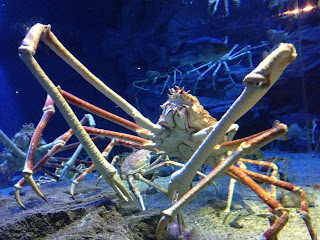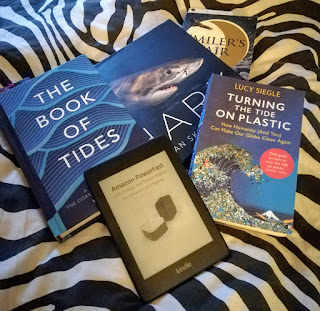Marine Creature of the Month August
Japanese Spider Crab
 |
| Photo from The Ethogram |
Kingdom: Animalia
Class: Malacostraca
Conservation Status: Not Evaluated (NE)
Found: Japanese waters, southern coast of Honshū
Diet: Omnivore
Weight: Up to 19kg (42lbs)
Size: Legs Up to 5.5m (18ft); Body up to 40cm (16”)
Habitat: Vents and holes on the substrate, deep ocean.
Japanese Spider Crabs are the largest of their kind. They are the largest arthropod around today. Arthropods are invertibrate creatures with an exoskeleton, segmented body and paired jointed appendages. They are also the largest crustacean living today. These guys are just big. And their size comes from their long, spindly legs. This gives them a somewhat terrifying look. For me, it brings, “One, two, three... lots of legs!” to mind. (Mermaid points if you get that reference.) Despite this, they are known to be rather gentle in disposition.
The Japanese spider crab is not a picky eater. Being omnivores, they eat both plant and animal matter. They will scavenge the dead, eat algae, or even pry open molluscs. They will literally eat anything they find on their substrate home. The substrate is the seabed, where a variety of sea creatures live. Japanese spider crabs live up to 600m (1970ft) in waters around 10C. They will, however, move up to shallower waters, around the 50m (160ft) mark during breeding season.
These monstrously huge creatures start life as planktonic larvae, which are microscopic creatures which float near the ocean’s surface in massive volumes. Safety in numbers. They hatch from eggs which the females carry on their abdominal appendages when they are fertilised. They spend roughly 54-72 days floating around as transparent, legless and round bodies. A very different picture to their fully fledged selves. They develop best in waters with temperatures of 12-15C. Once they have developed during this period, they settle back down on the substrate and mature. This is a common life cycle for fish across the seas.
This method clearly works, for there is evidence of these giantic crabs having been around for millions of years. There are at least two species from the same genus which have been discovered in fossilised remains. These fossils date back to the Miocene era, from 23 million to 5 million years ago.
What really makes these crabs distinct is their appearance, and no I don't mean their legs again. Well, a little bit. They, unlike other crabs, have twisted pleopods (which might just be my new favourite word, say it out loud, very satifying!). Pleopods are the legs all crabs and crustaceans use to swim. On their front legs they have chelipeds, which is a fancy word for claws. We are learning all the things! The males sport bigger chelipeds than the females.
My favourite thing about Japanese spider crabs is how they camoflauge themselves. Their orange and spotted exoskeleton is armoured and bumpy - giving it a very similar texture and appearance to the rocks they live amongst. They blend right in! To further this, they adorn sponges, plants and other critters around them! They literally dress themselves to look like their homes. And this is not exclusive to Japanese spider crabs. I have seen their smaller cousins off the Welsh coast, and they too utilise the same tactic. They looked like little walking forests.
This method clearly works, for there is evidence of these giantic crabs having been around for millions of years. There are at least two species from the same genus which have been discovered in fossilised remains. These fossils date back to the Miocene era, from 23 million to 5 million years ago.
What really makes these crabs distinct is their appearance, and no I don't mean their legs again. Well, a little bit. They, unlike other crabs, have twisted pleopods (which might just be my new favourite word, say it out loud, very satifying!). Pleopods are the legs all crabs and crustaceans use to swim. On their front legs they have chelipeds, which is a fancy word for claws. We are learning all the things! The males sport bigger chelipeds than the females.
My favourite thing about Japanese spider crabs is how they camoflauge themselves. Their orange and spotted exoskeleton is armoured and bumpy - giving it a very similar texture and appearance to the rocks they live amongst. They blend right in! To further this, they adorn sponges, plants and other critters around them! They literally dress themselves to look like their homes. And this is not exclusive to Japanese spider crabs. I have seen their smaller cousins off the Welsh coast, and they too utilise the same tactic. They looked like little walking forests.
 |
| Photo from Epic Wildlife |
Fun Facts!
- They have the largest leg span of any arthropod living; reaching spans up to 5.5m (18ft)!
- The Japanese name for the spider crab is taka-ashi-gani which literally translates to "tall legs crab".
- They are considered a delicacy in Japan.
- The largest spider crab on display has been dubbed "Crabzilla", he is 40 years old and 3.6m (12ft) tip to tip.



Comments
Post a Comment